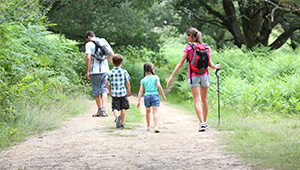How to Ensure Happy Trails on a Day Hike


Before you go
Check out the environment. Often, parks produce pamphlets or flyers about the trails and flora (plant life) and fauna (animal life) of the area. Call to see if the visitor’s center mails literature. Or if the park is close by, pick up the information. Large parks might post Web sites. You may discover that wildflowers blanket the hillside during the spring, or that a duck pond lies beside the start of a trail, or that deer graze in the meadows along the way. If possible, before settling on a place to go, check for descriptions of the trails. A short, flat route is easiest for little legs.
Get your child excited about going on a hike. You may not want to mention the hike until a couple of days before you go (time is still a developing concept for your child, and he may not understand that the trip is days away). But you can start looking through picture books that feature animals you might encounter on your walk. Don’t promise a sighting, however; you never know for sure what you’ll see or not see along the way. A simple pre-hike activity, such as tracing leaves and coloring them in, can also help build excitement for the outing.
When to go
Let the sun be your guide. If your child is keen to see wildlife, many animals – (early) birds included – are more active in the cooler, morning hours. If you’re hoping for a Bambi sighting, deer tend to graze during the early evening hours, just before sunset, as well as in the morning, as do bunnies. Turtles often catch midday rays by basking on a rock or log. For humans, mornings and evenings are usually a more comfortable time to hike in the summertime. In the fall and winter, when mornings are chillier, midday can be a lovely time to go.
Mark the seasons. If you find an interesting trail near your home, consider hiking it during each season of the year. This will start to introduce the concept of calendars and seasons and how things change throughout the year. In the fall, point out how the leaves are changing color. In the spring, point to new buds on the trees and the flowers pushing up through the ground. Those summer butterflies are sure to thrill your child. And your child will likely find interest and beauty even in a landscape dressed in winter starkness.
Once you’re there
Touch with care. A nature walk can be a tactile adventure for your hands-on child. Pinecones or pebbles or a bird feather (don’t touch it if it’s still attached to a dead bird!) on the trail are exciting discoveries. Just be aware of what your child is touching, and remind him to never go off the trail. You don’t want to bring home a case of poison oak or ivy. These plants have three green leaves in the spring and summer; in early fall, the leaves can turn yellow or red. Poison ivy grows as a vine or a low shrub. In the western part of the country, poison oak grows as a low or high shrub; in the eastern states, it grows as low shrub. (For more information on these poisonous plants, visit the American Academy of Dermatology Web site. www.aad.org)
Also, as tempting as it is to pick a poppy or take a pinecone home, remind your child that anything you take means that the next person won’t be able to see it. Explaining that the forest or meadow (or wherever you are) is a home to many animals and plants will help foster a respect for nature. You might help your child resist this temptation by gently asking, “You wouldn’t like it if someone came into our house and took one of your toys, would you?”
Pretend to be a member of Mother Nature’s family along the way. You might ask your child, “If you were a bird, where would you build your nest or get a drink of water or look for worms?” Pretend to be a deer foraging for berries (you might want to bring some along as a snack), for example. And just in case you don’t see Bambi along the way, you can guess where the real deer family is resting, and talk about a good place for your family to stop for a break.
If possible, walks a loop trail. These trails circle around, bringing hikers back to where they started – without having to backtrack. The no-repeat terrain of a loop trail means different scenery the whole way, which makes for a more interesting hike. However, if you don’t have any loop trail options, be sure to account for the time it will take to get back to your starting point.
For the budding naturalist. Consider bringing along flashcards of leaves, flowers, shrubs, trees, or birds to see if you can identify any of the illustrations or photos in real life.
Time your hike. Many variables influence how long your child will want to walk. But a well-rested, well-fed child will be more energetic. It’s best to go on shorter, more frequent walks. Take a morning walk, stopping for a picnic and a rest, and finish up with another walk. As a general rule of thumb, count on an hour or less per hike. If you want to try a longer walk, consider carrying your child in a backpack. Many packs hold a child up to 45 pounds.
The purr-fectly packed backpack
- Plenty of water.Some packs have loops on the outside for water bottles, a nice feature that eliminates fumbling inside the pack every time you or your child wants a drink.
- Consider whole-wheat breadsticks or string cheese, apples or pears, dried fruits, graham crackers, bran muffins, fig bars, ginger snaps, and, of course, trail mix.
- Sunscreen, hats, and insect repellent(with no more than 10 percent DEET)
- Trash bagsto carry your trash out (no littering!)
- First-aid kit
- Cell phone, turned off
- Rain gear
- Light jacketin cooler weather
- Camera
Footwear
- Comfortable sneakers.Your child probably doesn’t need hiking boots for a short nature walk.
- Long socks keep poison ivy or poison oak from rubbing up against exposed ankles.Also, socks keep spiders from biting and ticks from latching on for a ride – if you’re in an area where these bugs thrive.
- An extra pair of shoes and clothes.Leave these in the car – a wet hiker can get grumpy on the ride home.
Bring the experience home
Introduce some pond ecology. The next time your child has some friends over, make a pond in your backyard or family room (if it’s raining). Using yarn, outline “the pond,” and then assign each child a role: bug, frog, owl, hawk, fish. Announce a game of tag inside the pond: The frog tags the bug. The owl tags the frog. And the hawk tags the fish. Then switch roles. It’s a fun lesson in pond ecology – you’ve set up a food chain.
A fun fact
Some cottontail rabbits warn their buddies of potential danger by thumping their hind feet. (Remind you of any particular Disney character?) After the paw-banging announcement, the rabbits scatter – possibly confusing the enemy.
This article has been adapted from original content written and provided by BabyCenter.com. © BabyCenter, L.L.C. 2005. All rights reserved.


